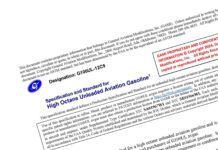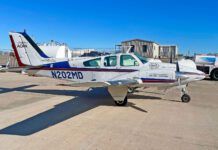In the May and June 2022 issues of Aviation Consumer, we reported on the ongoing activities of the general aviation alphabet groups and the FAA to revive the failed Piston Aviation Fuel Initiative and incorporate a new government/industry effort christened as EAGLE (Eliminate Aviation Gasoline Emissions—by 2030) project.
Half-expecting we would be pumping GAMI’s G100UL by now (a year later), we’re taking a hard look at where the general aviation piston engine community stands and what are the realistic prospects for a “drop-in,” “fleet-wide” replacement for the 80-some-year-old industry standard high-octane leaded aviation gasoline.
TERMINOLOGY
As we’ve watched this subject carefully, we’ve observed a great deal of confusion and misinformation being exchanged, often by those among the alphabet groups and sponsors of some of the proposed high-octane unleaded avgas fuel chemistry formulations who, in our view, should be more candid on their fuel tech.
Moreover, threatening a regulatory approval process that has worked for years, it’s easy to be angered that EAGLE and the alphabet groups have failed to clearly define the terms tossed around blithely—particularly “fleet-wide approval” and “drop-in replacement for 100LL.”
To put a stop to the misinformation and disinformation being slung we propose the following accurate, straightforward definitions:
• Fleet-wide approval—FAA regulatory approval that allows a new fuel formulation (chemistry) to be used on every existing spark-ignition piston engine and every associated airplane found anywhere in the FAA engine and airplane databases, without modification to the engines or aircraft (other than routine placards).
• Drop-in replacement for 100LL—A fuel with fleet-wide approval, which can be substituted for 100LL and transparently intermixed with 100LL in the fuel tanks of the aircraft and in the storage tanks at the airports, without any alteration to aircraft engines or airframes.
WHERE WE ARE
The search for an unleaded fuel started in the 1980s. The hope was that some replacement for lead could be found while keeping everything else in the composition the same. Little by little, researchers discovered that idea wouldn’t work. We think GAMI’s George Braly put it best a few years back: “The industry needs to find a ‘fuel that works’ and then write a commercial specification that clearly defines it so that any qualified refiner (or blender) could produce the new fuel.”
It took some time, but the general aviation industry and fuel suppliers have come to the same conclusion. There are now four visible fuel chemistries proposed:
1. Lyondell and VP Racing.
2. Phillips 66 and Afton Chemical.
3. Swift Fuels and UL100R.
4. GAMI and G100UL.
Some comments about the sponsors: Phillips is possibly the largest producer of 100LL. Afton Chemical is a corporate sister company to Ethyl Corporation, which currently imports and distributes tetraethyl lead (TEL). We wonder how motivated they are to find a replacement for 100LL.
Lyondell and Phillips 66 formulations look much like the fuel chemistry in 100LL—each uses manganese (formulated as a product called MMT) as an octane enhancer. Little is known publicly about further details.
By contrast, Swift Fuels has published a great deal about its UL100R. Its FAQ (www.swiftfuelsavgas.com/faq) states that certification testing and development of an ASTM fuel specification is currently in progress. However, at the last ASTM meeting in Orlando, Florida, Swift announced that it would first submit its proposed UL100R specification to the ASTM organization sometime in early 2023. Surprisingly, it then asked the ASTM to waive its long-standing practice of extensively reviewing and vetting any proposed new fuel specification to ensure that the fuel composition of any later testing that was done on that proposed new fuel would, in fact, conform to the industry consensus ASTM committee’s criteria for a proper specification.
In our opinion, this at least gives the appearance of attempting to sidestep ASTM’s quality control procedures.
The next regular ASTM meeting is scheduled for June 2023. So far as we have been able to determine, at the time this went to press, Swift had not submitted the proposed initial “test” specification for consideration of the ASTM committee formed to review the Swift fuel proposal. If and when that document is public, we will attempt to review it.
We note that some months ago we offered Swift Fuels space in these pages to comment on its technology and unleaded avgas in general. To date we have not received a response. The offer remains open for an ongoing honest and educational discussion.
Without test specs, it’s difficult to know exactly what is in UL100R, although clues can be found in Swift’s most recent UL100R patent application. To find the patent application, go to www.patents.google.com and enter the patent number, 10450526.
Swift’s patent application discloses the planned use of the “oxygenate” ETBE at a level of 40 percent of the UL100R fuel formulation. (The banned MTBE previously used in automotive gasoline in the U.S. is similar, but ETBE is made from ethanol feed stock, rather than methanol feed stock.)
POWER AND RANGE LOSS
However, the patent also discloses that there are 5 to 8 percent fewer BTU/gallon in UL100R compared to standard 100LL. The patent acknowledges the impact of the use of ETBE will likely reduce the range of the aircraft by 5 to 8 percent. Also a concern is that it appears there will be many engines that would have to have their fuel flow systems adjusted to increase the full rich fuel flow to provide the same level of energy content as is required to pass the FAA detonation testing margins.
That means, in many airplanes, pulling fuel system components and sending them out for expensive work—and then it appears that the engine can’t use 100LL.
Further, according to Swift’s patent filings, UL100R, in a “preferred” formulation, would have 40 percent ETBE and about 57 percent of standard aviation alkylate and 250 PPM of ferrocene. Ferrocene is another organometallic compound as is tetraethyl lead in 100LL. When lead was being banned in automotive fuel, there were volumes of studies that demonstrated that ferrocene routinely fouled automotive spark plugs in under 100 hours.
One of the reasons we’ve been pushing for unleaded avgas was to finally get rid of the spark plug fouling issues.
The proposed UL100R formulations using standard aviation alkylate claim to have a Motor Octane Number (MON) of at least 96. 100LL has a minimum MON of 99.6 (which was rounded to 100). Swift claims that the formulations of UL100R with a MON of 98 (made with 250 PPM of iron-based ferrocene) will have “equivalent anti-knock performance” to ASTM standard 100LL. For now, color us skeptical.
NO “SUPERCHARGE”?
What strikes us as very significant is Swift’s complete absence of any reference to the “other” octane parameter—in addition to 100 MON—in 100LL. The ASTM D910 specification for 100LL includes a requirement for a “Supercharge” octane rating of at least 130. Remember, the fuel used to be called 100/130.
The “Supercharge” rating is essential to the detonation resistance of the engine at full power with a full rich mixture. As far as we’re concerned, this is basic—it’s been a part of our avgas for over 80 years.
By contrast, GAMI’s G100UL has a disclosed “Supercharge” rating that is we’ll in excess of the high-octane purple avgas used in WWII combat aircraft and subsequent piston airliners, 115/145.
We do not know why Swift has not met the ASTM D910 supercharge specification by this late date. We wonder if it can, but doubt that it is going to try—based on a FAQ on its website:
Question: “Is Swift Fuels’ 100-octane Avgas ‘Drop-In-Ready’?”
Answer: “For an estimated 85% of the US piston fleet, it is anticipated that our 100-octane unleaded avgas will be 100% drop-in-ready meaning no aircraft modification or hardware of any type are required.” In our opinion, that is Orwellian doublespeak.
EAGLE’S COMPLAISANCE
Why hasn’t EAGLE called Swift, Phillips 66, Afton Chemical, Lyondell or VP Racing on their glaring, to us, shortcomings? In our opinion, EAGLE exists to provide a fleet-wide unleaded fuel solution and its public actions, for reasons unknown to us, certainly seem to indicate that it is acting as a cheerleader for fuels that are currently incapable of becoming one—while pushing aside the one that is already fully FAA-certificated.
From available evidence we know:
• While much of Lyondell and VP Racing’s candidate fuel formulation is unknown, they have disclosed that it has significant levels of manganese. Recent FAA testing demonstrated the accumulation of unacceptable manganese deposits in combustion chambers within less than 100 hours of operation. It is not yet approved by the FAA.
• Phillips 66 and Afton Chemical—essentially we know the same as we know about Lyondell and VP Racing and the unacceptable problem with manganese. Also not yet approved by the FAA.
• Swift Fuels and UL100R—from all available evidence it is neither a drop-in replacement for the entire fleet nor a fleet-wide solution. It has not yet been approved by the FAA or ASTM.
• GAMI and G100UL avgas—drop in, fleet-wide replacement, certificated by the FAA and beginning to appear on the market.
CALIFORNIA FBOS
In a case of the elephant in the room, we note that, pursuant to an Order entered in case number RG-11-600721, in Superior Court for the State of California, Alameda County, on Dec. 9, 2014, FBOs at some 24 airports in California are currently under a requirement to stop selling 100LL and replace it with a lower-lead or no-lead avgas as soon as it is commercially available. The penalties are not pretty.
G100UL is certificated and becoming commercially available—although EAGLE’s foot-dragging is slowing the process.
We must assume that those FBOs are beating GAMI’s doors down with demands for delivery because the organization that brought the lawsuit seems to be serious about getting the lead out of all avgas sold in California.
CONCLUSION
EAGLE’s mandate was to deliver an FAA-approved, fleet-wide, drop-in unleaded avgas. Mission accomplished. We should be partying.
However, EAGLE’s actions since G100UL approval have only delayed getting the successful unleaded avgas into the field. Refiners are not signing on to make and deliver the fuel because EAGLE’s behavior causes them to fear that, with seven years remaining on its mandate, EAGLE will do something downstream to cut them off at the knees.
From what we’ve seen, it’s our opinion that EAGLE should change its acronym from a soaring bird to a flightless one—KIWI—Keep Industry Waiting Indefinitely.
We think that it’s time for Eagle to declare victory, disband and finally get the lead out.




